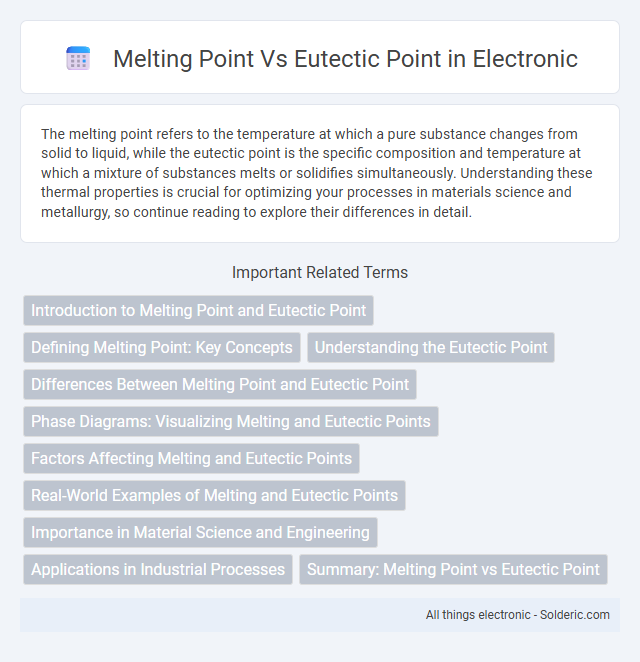The melting point refers to the temperature at which a pure substance changes from solid to liquid, while the eutectic point is the specific composition and temperature at which a mixture of substances melts or solidifies simultaneously. Understanding these thermal properties is crucial for optimizing your processes in materials science and metallurgy, so continue reading to explore their differences in detail.
Comparison Table
| Feature | Melting Point | Eutectic Point |
|---|---|---|
| Definition | Temperature at which a solid turns into liquid at atmospheric pressure. | Lowest temperature at which a mixture of substances melts simultaneously. |
| Applicability | Pure substances. | Mixtures or alloys. |
| Temperature | Specific for each pure material. | Unique for each specific mixture composition. |
| Phase Transition | Solid to liquid at one temperature. | Simultaneous melting of multiple solid phases. |
| Significance | Determines purity and thermal properties. | Defines optimal melting point for mixtures, important in metallurgy and material science. |
Introduction to Melting Point and Eutectic Point
Melting point refers to the specific temperature at which a pure substance changes from solid to liquid, marking a phase transition. The eutectic point is the lowest temperature at which a mixture of two or more components solidifies simultaneously, exhibiting a unique composition and melting behavior. Understanding these concepts helps you analyze material properties and optimize processes in fields like metallurgy and pharmaceuticals.
Defining Melting Point: Key Concepts
The melting point is the specific temperature at which a pure substance transitions from solid to liquid under standard atmospheric pressure, reflecting its inherent thermal stability. This property is critical for identifying and characterizing materials, as it corresponds to the energy required to overcome lattice forces in a crystalline structure. Unlike the eutectic point, which defines the lowest melting temperature for a mixture of components that solidify simultaneously, the melting point pertains strictly to individual substances.
Understanding the Eutectic Point
The eutectic point represents the lowest temperature at which a specific mixture of substances solidifies simultaneously, unlike a pure compound's melting point where it changes phase at a fixed temperature. At the eutectic composition, both components crystallize together, forming a unique microstructure that is crucial in alloy design and pharmaceuticals. Understanding this point allows precise control over phase transitions and enhances material properties by manipulating solidification behaviors.
Differences Between Melting Point and Eutectic Point
The melting point is the temperature at which a pure substance transitions from solid to liquid, marking a distinct and sharp phase change. The eutectic point, by contrast, refers to the lowest temperature at which a mixture of substances solidifies simultaneously, resulting in a unique composition with a specific melting behavior. Understanding these differences is crucial for controlling alloy properties and optimizing material processing in your applications.
Phase Diagrams: Visualizing Melting and Eutectic Points
Phase diagrams visually represent the melting point and eutectic point to illustrate the thermal behavior of mixtures and pure substances. The melting point appears as a single temperature line where a pure component transitions from solid to liquid, while the eutectic point indicates the lowest temperature at which a specific mixture solidifies into multiple phases simultaneously. These diagrams are essential for understanding alloy solidification, enabling precise prediction of phase transitions and material properties during heating or cooling.
Factors Affecting Melting and Eutectic Points
Melting points are influenced primarily by molecular structure, intermolecular forces, and purity of the substance, where stronger forces and higher purity generally increase the melting temperature. Eutectic points depend on the specific composition ratios and interactions between multiple components in an alloy or mixture, resulting in a unique, lower melting temperature than individual constituents. Understanding these factors helps you predict material behavior for applications in metallurgy, pharmaceuticals, and materials science.
Real-World Examples of Melting and Eutectic Points
The melting point is the temperature at which a pure substance transitions from solid to liquid, such as ice melting at 0degC, while the eutectic point refers to the specific composition and temperature where a mixture of substances solidifies simultaneously at the lowest melting temperature, exemplified by the eutectic mixture of lead and tin at 183degC used in soldering. Real-world applications include the precise control of alloy compositions in metalworking to optimize strength and melting characteristics, and in pharmaceutical formulations where eutectic mixtures improve drug solubility and bioavailability. The eutectic point's significance lies in its ability to create materials with tailored melting properties distinct from the individual components' melting points.
Importance in Material Science and Engineering
The melting point and eutectic point are critical parameters in material science and engineering for designing alloys and composites with desired thermal and mechanical properties. Understanding the eutectic point enables precise control over phase transitions, optimizing microstructure and enhancing material performance such as hardness and corrosion resistance. Materials engineered around these points improve manufacturing processes like casting and soldering by reducing defects and increasing efficiency.
Applications in Industrial Processes
Understanding the difference between melting point and eutectic point is crucial in industrial processes such as alloy manufacturing and pharmaceutical formulation. The melting point defines the temperature at which a pure substance turns from solid to liquid, while the eutectic point represents the lowest temperature at which a mixture of substances melts simultaneously, optimizing material properties and processing efficiency. You can leverage eutectic points to design alloys or drug formulations with precise melting behaviors, improving product stability and manufacturing consistency.
Summary: Melting Point vs Eutectic Point
The melting point is the temperature at which a pure substance changes from solid to liquid, representing a single-component phase transition. The eutectic point refers to the specific temperature and composition at which a multi-component mixture solidifies simultaneously into two or more solid phases. Unlike melting points, eutectic points indicate the lowest temperature at which the liquid phase exists for a given mixture.
Melting point vs eutectic point Infographic

 solderic.com
solderic.com